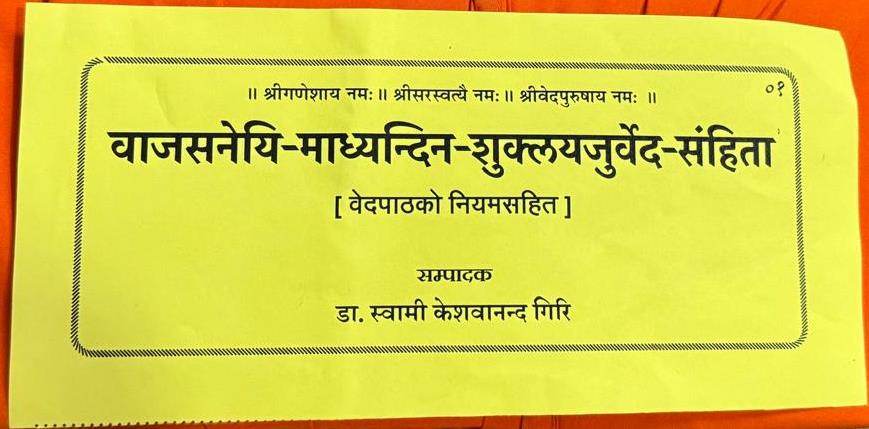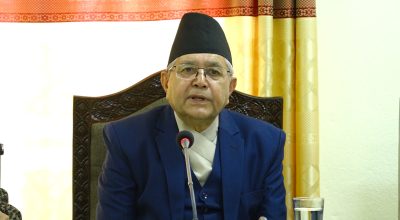
Purna Prasad Mishra
Kathmandu, Oct 27: The Vedic Research Guthi or Vaidic Anusandhan Guthi (VAG) has published the ‘Patre Veda’ (Veda texts in separate pages) for the first time in Nepal. The Guthi has published 40 chapters of the Vajasaneyi-Madhyandina-Shuklayajurveda Samhita (Code) in its original form.
The Guthi was established a year ago with the aim of preserving and promoting Vedic Sanatan Dharma, philosophy, rituals, culture, and Sanskrit-related texts. Its goals include studying, researching, editing, interpreting, analyzing, translating, and publishing ancient and modern texts; developing technology-friendly courses, textbooks, and audio-visual materials; running Gurukuls and Ashrams for the study and teaching of Sanskrit, rituals, and culture; and raising awareness among believers in Vedic literature to create units of specialized production.
The editing of this text, which includes the rules of Vedic recitation, was done by Dr. Swami Keshwanand Giri, who is also the founding president of the Guthi. The text provides information on how many chapters a group of two to four Brahmins should recite during Vedic recitation. The book also makes the study of Vedic recitation easier by including rules and conduct for Vedic scholars, rules for pronunciation, and methods of recitation.
The book covers the significance of the Vedas, their divisions, reasons behind the name Shukla Yajurveda, branches of Yajurveda, Vajasaneyi Madhyandina Samhita, Kanva Samhita, a brief overview of the four Vedas, and detailed information on the Shukla Yajurveda Madhyandina Samhita. It is designed to assist those wishing to perform Vedic recitation according to traditional methods.
This book has been printed in a thousand and one copies with the support of Murari Prasad Phuyal and his wife Sushila Phuyal from Kageshwori Manohara-6. There are two editions published: one on Nepali paper and another on standard paper. The book with cloth binding is available at the Guthi’s office in Gaurighat and at the Shankaracharya Math near the Pashupatinath Temple. The price of the book published on Nepali paper is Rs 11,111, while the one on standard paper is priced at Rs 1,111. The revenue from book sales will be used for studies and research related to the Vedic field by the Guthi.
Dr. Swami Keshwanand Giri has previously created and published the world’s largest Sanskrit-Nepali electronic dictionary, which includes meanings of words in Sanskrit, Nepali, Hindi, and English. This dictionary contains around 400,000 words across all four languages and can be downloaded for use on Android devices. Similarly, users can search for approximately 400,000 words by visiting the website knswami.com.
Dr. Giri has also published the Vajasaneyi-Madhyandina-Shuklayajurveda Samhita using the K.N. Swami Unicode font. Before this book, it was difficult to find a original version of Shukla Yajurveda published in Nepal.
Furthermore, he has published four parts of the Nepali translation of Laghu Siddhanta Kaumudi to make it easier for students wishing to learn Sanskrit. He undertook this project so that future students would not face difficulties in accessing study materials, as he did during his own studies. There is significant demand for these Eastern literary works from Nepali readers in countries like the USA, Canada, and Australia, as well as from communities in Burma, Bhutan, India, and Nepal.
Dr. Giri, who has conducted research for a doctorate from Nepal Sanskrit University on ‘Advaita Philosophy in Panini’s Ashtadhyayi,’ aims to integrate Eastern literature with technology to create a conducive environment for students and researchers. This is one of the reasons behind the establishment of the Guthi.
The Guthi has also launched a Mahabharata translation project, set to be completed by the end of this year. This project aims to translate the world’s largest epic, consisting of approximately 100,000 verses, from Sanskrit into Nepali for the first time. This foundational text of ancient literature is being translated by accredited scholars, with an estimated cost of around Rs 20 million.
Additionally, the Guthi is continuing the translation of the Ramayana, the world’s first poem, from Sanskrit into Nepali. This translation, consisting of about 24,000 verses, is expected to be completed by the end of this year. Like the Mahabharata, this will also be the first time the Ramayana is translated into Nepali, with an estimated cost of around Rs 4.5 million.
The Guthi has also created a Nepali-Sanskrit dictionary, which contains the meanings of over 25,000 Nepali words in Sanskrit. This is Nepal’s first official Nepali-Sanskrit dictionary, developed at a cost of about Rs 1 million, and is deemed useful for those studying Sanskrit.
The Guthi is planning to create the largest multilingual Sanskrit-Nepali, Hindi, and English electronic artificial intelligence (AI) dictionary. This dictionary, based on AI technology, will include categorized words and meanings, along with etymological explanations and examples. The project aims to be completed by the end of Ashad 2085 BS, with initial funding of Rs 1 million and an estimated total cost of Rs 50 million for second phase. #nepal #sanscrit #guthi #rss
















